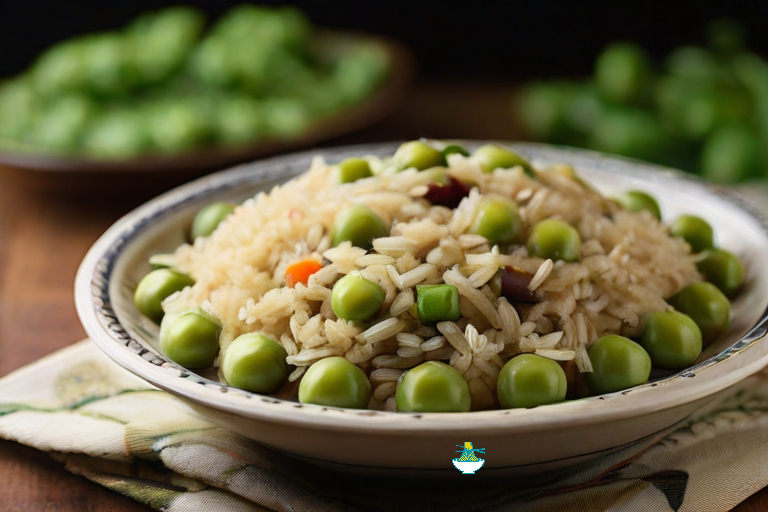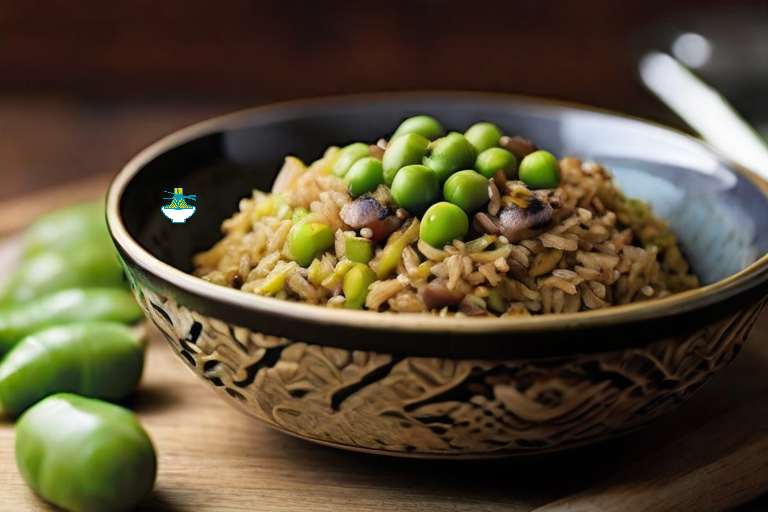Welcome to a culinary adventure that transports you to the vibrant and tropical paradise of Bermuda! In this recipe, we'll explore the delightful flavors of Bermuda Peas and Rice, a dish that perfectly captures the essence of this beautiful island. Known for its unique blend of African, Caribbean, and British influences, Bermudian cuisine is a celebration of diversity and bold flavors.
Bermuda Peas and Rice is a dish that reflects the island's rich history and cultural tapestry. Combining aromatic rice, tender pigeon peas, and a medley of herbs and spices, this recipe is a symphony of taste that will tantalize your palate and evoke the spirit of the sunny shores of Bermuda. Join us on this culinary journey as we delve into the ingredients, techniques, and traditions that make Bermuda Peas and Rice a beloved and comforting dish for both locals and visitors alike. Get ready to bring a taste of Bermuda to your table!
Ingredients:
- 2 cups long-grain white rice
- 1 cup dried pigeon peas (or canned pigeon peas, drained and rinsed)
- 1 medium onion, finely chopped
- 2 cloves garlic, minced
- 1 bell pepper, finely diced (any color)
- 1 medium tomato, diced
- 3 cups vegetable or chicken broth
- 1/2 teaspoon dried thyme
- 1/2 teaspoon paprika
- 1/4 teaspoon cayenne pepper (adjust to taste)
- Salt and black pepper to taste
- 2 tablespoons vegetable oil
- Fresh parsley or cilantro for garnish (optional)
Instructions:
Prepare the Pigeon Peas:
1-If using dried pigeon peas, soak them in water overnight. Rinse them thoroughly before cooking.
2-If using canned pigeon peas, drain and rinse them under cold water.
Sauté Aromatics:
1-In a large, heavy-bottomed pot, heat the vegetable oil over medium heat.
2-Add the chopped onion, minced garlic, and diced bell pepper. Sauté until the vegetables are softened and aromatic.
Add Rice and Spices:
1-Stir in the rice and cook for 2-3 minutes, allowing the rice to lightly toast.
2-Add the thyme, paprika, cayenne pepper, salt, and black pepper. Mix well to coat the rice with the spices.
Incorporate Pigeon Peas and Tomatoes:
1-Add the soaked and rinsed dried pigeon peas or the canned pigeon peas to the pot. Mix them evenly with the rice.
2-Toss in the diced tomato and stir to combine all the ingredients.
Pour in Broth:Pour the vegetable or chicken broth into the pot. Bring the mixture to a boil.
Simmer and Cook:Once boiling, reduce the heat to low, cover the pot with a tight-fitting lid, and simmer for 18-20 minutes or until the rice is tender and the liquid is absorbed.
Fluff and Garnish:
1-Once the rice is cooked, fluff it with a fork to separate the grains.
2-Optionally, garnish with fresh parsley or cilantro for a burst of freshness.
Serve:Bermuda Peas and Rice is ready to be served! Enjoy it as a flavorful side dish alongside your favorite main courses.
This Bermuda-inspired dish brings together the warmth of aromatic spices and the heartiness of pigeon peas, creating a side dish that's both comforting and full of island flair.
Nutritional Values:
Here are approximate nutritional values for the ingredients used in Bermuda Peas and Rice. Keep in mind that these values are general estimates and can vary based on specific brands and preparation methods.
Long-Grain White Rice (2 cups):
- Calories: 440
- Carbohydrates: 98g
- Protein: 8g
- Fat: 1g
- Fiber: 1g
Benefit: An excellent source of energy due to its high carbohydrate content. Additionally, it provides essential nutrients like B vitamins and iron.
Dried Pigeon Peas (1 cup, cooked):
- Calories: 200
- Carbohydrates: 39g
- Protein: 13g
- Fat: 1g
- Fiber: 9g
Benefit: Rich in protein, fiber, and various vitamins and minerals. Pigeon peas contribute to muscle building, digestive health, and overall nutritional balance.
Onion (Medium-sized):
- Calories: 45
- Carbohydrates: 11g
- Protein: 1g
- Fat: 0g
- Fiber: 2g
Benefit: Onions are low in calories but high in antioxidants and various vitamins. They may have anti-inflammatory and immune-boosting properties.
Garlic (2 cloves):
- Calories: 10
- Carbohydrates: 2g
- Protein: 0g
- Fat: 0g
- Fiber: 0g
Benefit: Known for its potential health benefits, garlic has anti-inflammatory and antioxidant properties. It may also support heart health and boost the immune system.
Bell Pepper (Medium-sized, any color):
- Calories: 25
- Carbohydrates: 6g
- Protein: 1g
- Fat: 0g
- Fiber: 2g
Benefit: Bell peppers are high in vitamin C, antioxidants, and fiber. They contribute to skin health, immune function, and overall well-being.
Tomato (Medium-sized):
- Calories: 22
- Carbohydrates: 5g
- Protein: 1g
- Fat: 0g
- Fiber: 2g
Benefit: Tomatoes are rich in vitamins (especially vitamin C), antioxidants, and lycopene. They may have heart-protective and anti-cancer properties.
Vegetable or Chicken Broth (3 cups):
- The nutritional content can vary widely based on the specific brand and recipe used. Store-bought versions typically contain low calories, fat, and protein.
Benefit: Provides a flavorful base for the dish. Broths can contribute to hydration and may contain some vitamins and minerals.
Dried Thyme (1/2 teaspoon):
- Negligible caloric contribution; mainly used for flavor.
Benefit: Thyme is a herb with potential antibacterial and anti-inflammatory properties. It adds flavor without extra calories or sodium.
Paprika (1/2 teaspoon):
- Negligible caloric contribution; mainly used for flavor.
Benefit: Paprika, derived from peppers, contains antioxidants and may have anti-inflammatory effects. It adds color and flavor to the dish.
Cayenne Pepper (1/4 teaspoon):
- Negligible caloric contribution; mainly used for flavor.
Benefit: Cayenne pepper contains capsaicin, which may boost metabolism and have anti-inflammatory properties. It adds a spicy kick to the dish.
Salt and Black Pepper (to taste):
- Negligible caloric contribution; mainly used for flavor.
Benefit: Used in moderation, salt enhances flavor, and black pepper adds a mild heat. Both can contribute to the overall taste satisfaction.
Vegetable Oil (2 tablespoons):
- Calories: 240
- Carbohydrates: 0g
- Protein: 0g
- Fat: 28g
- Fiber: 0g
Benefit: Provides healthy fats, particularly unsaturated fats. Vegetable oil is a source of energy and helps in the absorption of fat-soluble vitamins.
Fresh Parsley or Cilantro (for garnish, optional):
- Negligible caloric contribution; mainly used for flavor.
Benefit: Both parsley and cilantro are rich in vitamins and antioxidants. They can add freshness and enhance the visual appeal of the dish.
Remember, these values are general estimates and can vary based on the specific brands and quantities used in your recipe. Additionally, the nutritional content of broth can vary, so it's recommended to check the packaging for accurate information.


Comments